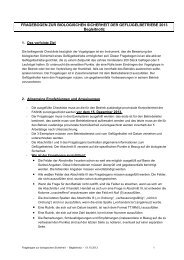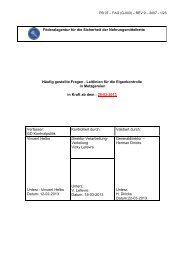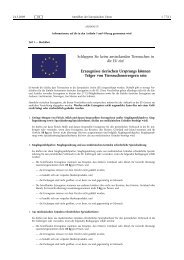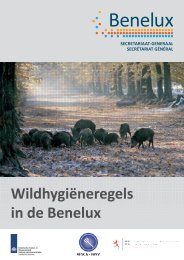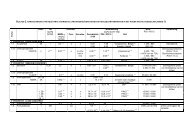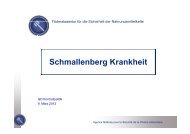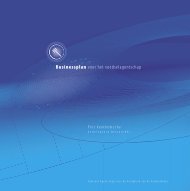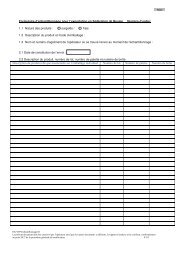ADVIES 29-2009 van het Wetenschappelijk Comité van het FAVV
ADVIES 29-2009 van het Wetenschappelijk Comité van het FAVV
ADVIES 29-2009 van het Wetenschappelijk Comité van het FAVV
Create successful ePaper yourself
Turn your PDF publications into a flip-book with our unique Google optimized e-Paper software.
Liehr JG, Somasunderam A, Roy D. 1998. Natural and anthropogenic environmental<br />
oestrogens: the scientific basis for risk assessment. Metabolism and fate of xeno-oestrogens<br />
in man. Pure and Appl. Chem., 70 (9),1747-1758.<br />
Maghuin-Rogister G. 1991. The Residue Problem. In : « Animal Biotechnology and the<br />
Quality of Meat Production », L.O. Fiems, B.G. Cottyn and D.I. Demeyer (Eds), 1991 Elsevier<br />
Science Publishers B.V. Amsterdam, pp 179-189.<br />
Matthews J., Wihlen, B., Thomsen J., Gustafsson J. A. 2005. Aryl hydrocarbon receptormediated<br />
transcription: ligand-dependent recruitment of estrogen receptor alpha to 2,3,7,8tetrachlorodibenzo-p-dioxin-responsive<br />
promoters. Mol. Cell Biol., 25, 5317-5328.<br />
Miyamoto J, Klein W. 1998. Natural and anthropogenic environmental oestrogens: the<br />
scientific basis for risk assessment Environmental exposure, specifies differences and risk<br />
assessment. Pure and Appl. Chem., 70 (9), 18<strong>29</strong>-1845.<br />
Nash JP, Kime DE, Van der Ven LTM, Wester PW, Brion F., Maack G, Stahlschmidt-Allner P,<br />
Tyler CR. 2004. Long-term exposure to environmental concentrations of the pharmaceutical<br />
ethinylœstradiol causes reproductive failure in fish. Environm. Health Pers., 112 (7), 1725 –<br />
1733.<br />
OECD, 2000. Protocol for investigating the efficacy of the Enhanced TG 407 Test Guideline<br />
(phase 2). Rationale for the investigation, and description of the protocol (issued 4 May,<br />
2000). Organisation for Economic Co-operation and Development, Paris.<br />
http://www.oecd.org/document/42/0,3343,en_2649_34377_2348650_1_1_1_1,00.html<br />
Overk C R, Guo J, Chadwick L R, Lantvit D D, Minassi A, Appendino G, Chen S-N, Lankin D<br />
C, Farnsworth N R, Pauli G F, <strong>van</strong> Breemen R B, Bolton J L. 2008. In vivo estrogenic<br />
comparisons of Trifolium pratense (red clover) Humulus lupulus (hops), and the pure<br />
compounds isoxanthohumol and 8-prenylnaringenin. Chemico-Biol. Interact., 176, 30–39.<br />
Pinto B., Reali D. <strong>2009</strong>. Screening of estrogen-like activity of mineral water stored in PET<br />
bottles. Int.J. Hyg. Envir. Health, 212, 228-232.<br />
Piva F., Martini L. 1998. Natural and anthropogenic environmetal oestrogens: the scientific<br />
basis for risk assessment Neurotransmitters and the control of hypophyseal gonadal<br />
functions: possible implications of endocrine disruptors. Pure and Appl. Chem., 70 (9), 1647-<br />
1655.<br />
Possemiers S. 2007. Activation of proestrogens from hops by human intestinal bacteria:<br />
conversion of isoxanthohumol into the potent phytoestrogen 8-prenylnaringenin. PhD thesis,<br />
Ghent University, Belgium.<br />
Preziosi. 1998. Natural and Anthropogenic Environmental Oestrogens. The scientific basis for<br />
risk assessment. Endocrine disrupters as environmental signallers: an introduction, Pure and<br />
Appl. Chem., 70 (9), 1617-1631.<br />
Ritchie MR, Cummings JH, Morton MS, Michael Steel C, Bolton-Smith C, Riches AC. 2006. A<br />
newly constructed and validated isoflavone database for the assessment of total genistein<br />
and daidzein intake. Br J. Nutr., 96 (1), 204-13.<br />
SCF, 2002. Opinion of the Scientific Committee on Food on the risks to human health of<br />
Polycyclic Aromatic Hydrocarbons in food. SCF/CS/CNTM/PAH/<strong>29</strong> Final<br />
Scientific Committee on Consumer Products (SCCP), 2008. Opinion on 4-Methylbenzylidene<br />
camphor (4-MBC). SCCP/1184/08.<br />
Scippo ML, Maghuin-Rogister G, 2007. Les perturbateurs endocriniens dans l’alimentation<br />
humaine: impact potentiel sur la santé. Ann. Méd. Vét. (1), 151, 44-54.<br />
Sekizawa J. 2008. Low-dose effects of bisphenol A: a serious threat to human health?. J.<br />
Toxicol. Sci., 33 (4), 389-403.<br />
Sharpe RM. 1998. Natural and Anthropogenic Environmental Oestrogens. The scientific basis<br />
for risk assessment. Environmental oestrogens and male infertility. Pure and Appl. Chem., 70<br />
(9), 1685-1701.<br />
20


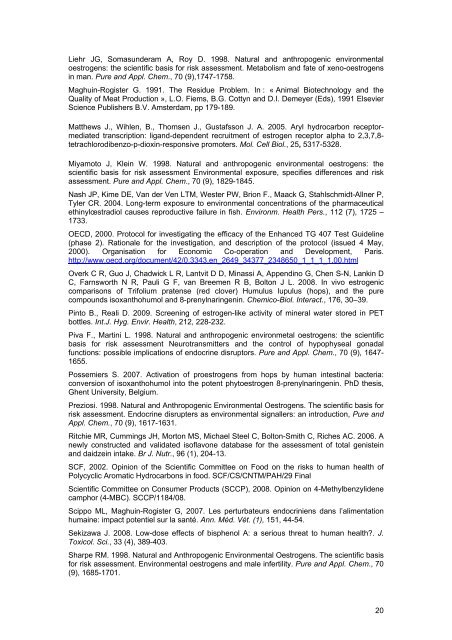
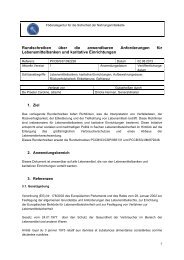
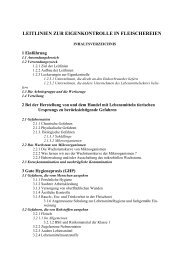

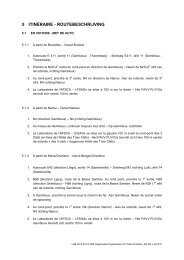
![DPA 2298 Schweine: Aujeszky-Impfung [2298] v2 - FAVV](https://img.yumpu.com/22032815/1/184x260/dpa-2298-schweine-aujeszky-impfung-2298-v2-favv.jpg?quality=85)
